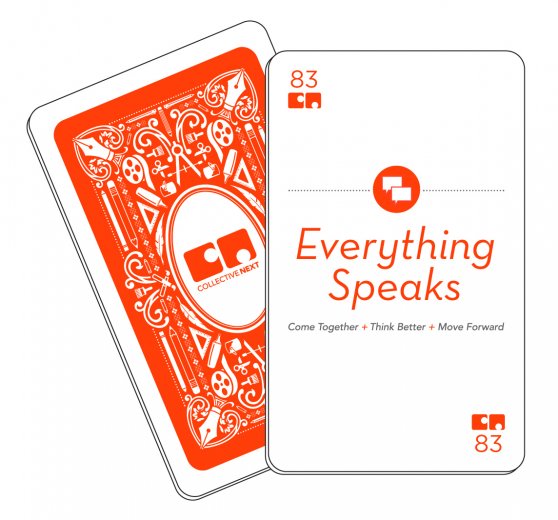This is one of a series of posts we’re running this summer about the Collective Next Cards.
I am NOT a detail-oriented person. However, I’ve been lucky to be mentored and taught by folks such as Matt Taylor, Michael Bell, Kelvy Bird, and many others who impressed upon me the importance of the phrase “Everything Speaks.” Work does not occur in a vacuum. The environment and experience that surround and support our work is just as important as the actual work itself.
We ask our clients to make hard choices during our design sessions. Those choices have meaningful impacts not only on their business but also on the people that work with and for them — and for the clients and customers who use their products or services.
We believe that creating an intensely intentional environment and human experience helps ensure that these decisions and designs are as thoughtful as possible.
Everything Speaks is our code phrase for details matter. We’ve all had the experience where a poor interaction has taken what could have been a good or neutral moment and made it a poor one.
For instance, you walk up to a table with nametags on it and you don’t have a tag there for you. It immediately can spark self-doubt (“Was I invited to this session? Why was I left off the list?”) or frustration (“They aren’t even organized enough to have all the right tags out here. This is going to be a waste of my time.”).
The same is true of the physical space where a meeting occurs. If there is a piece of paper on the floor near a trash can, a marker cap underneath a table, or random writing on a white board -– it creates space for a participant to doubt the meeting and the process or question the abilities of the facilitation team.
On the flip side, an environment and experience that is perfectly orchestrated not only allows the participants to focus on the work and only the work, but also models a great solution and can subconsciously help set their expectations for their own success.
This orchestration includes many little things that add up to a perfect harmony. For instance: walking into a breakout area and having exactly the right number of chairs. Or when you head to a whitewall to take notes, having all the markers you need, as well as an eraser for when you need to make that inevitable iteration. It’s about having the same person who designed the meeting, is facilitating it, come over to your table as lunch time wraps and helps clear your dishes so that you can continue to focus on your assigned deliverable. It’s even about the music -– where the word choice, rhythm, speed, and volume of the song being played as a correlation to the design of the event, and the expectations of the participants in that moment.
Everything Speaks can seem like a burden. There are so many things to manage that sometimes it feels impossible to do them all perfectly. Instead you have to look at this as an opportunity and know that everything we tweak, everything we decide about the environment and experience, gives our participants that much more of an advantage, that much more of a chance at real success.
Back






